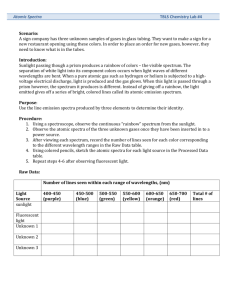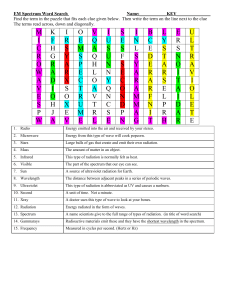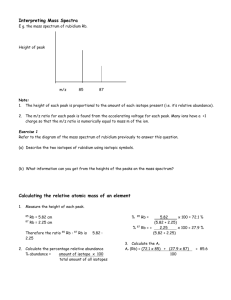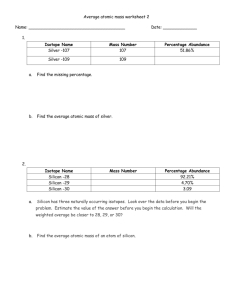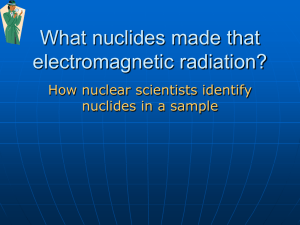Research Journal of Applied Sciences, Engineering and Technology 2(2): 153-155,... ISSN: 2040-7467 © M axwell Scientific Organization, 2010
advertisement
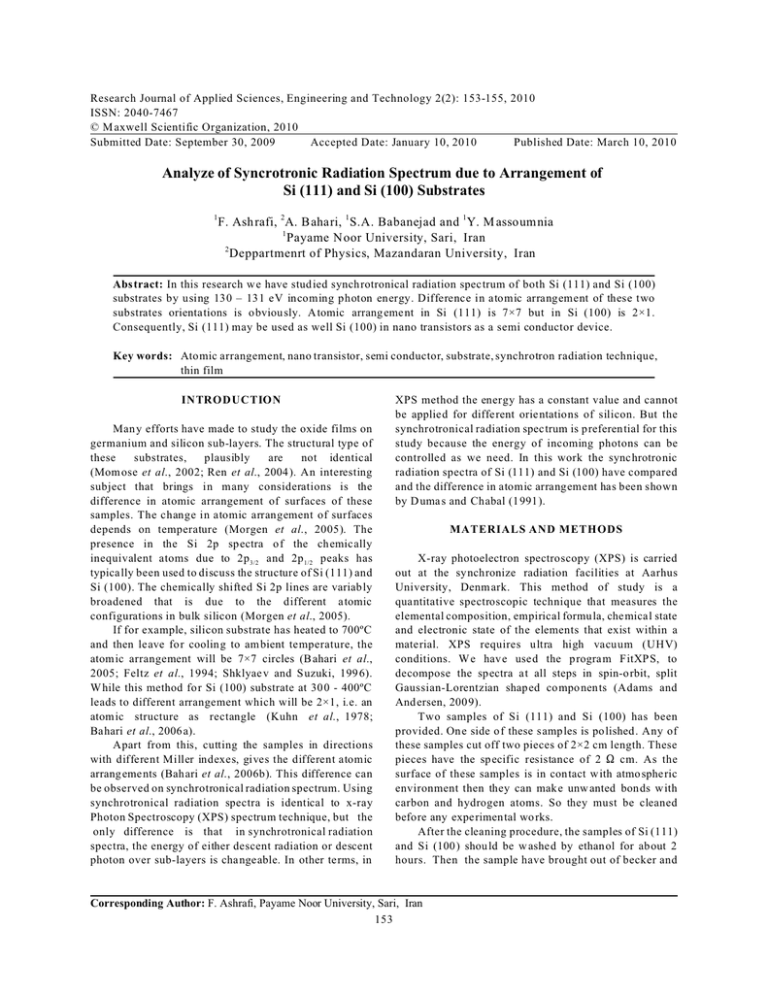
Research Journal of Applied Sciences, Engineering and Technology 2(2): 153-155, 2010 ISSN: 2040-7467 © M axwell Scientific Organization, 2010 Submitted Date: September 30, 2009 Accepted Date: January 10, 2010 Published Date: March 10, 2010 Analyze of Syncrotronic Radiation Spectrum due to Arrangement of Si (111) and Si (100) Substrates 1 F. Ash rafi, 2 A. B ahari, 1 S.A. Babanejad and 1 Y. M assoumnia 1 Payame N oor University, Sari, Iran 2 Deppartmenrt of Physics, Mazandaran University, Iran Abstract: In this research w e have stud ied synch rotronical radiation spectrum of both Si (111) and Si (100) substrates by using 130 – 131 eV incoming photon energy. Difference in atomic arrangement of these two substrates orientations is obviou sly. Atomic arrang eme nt in Si (111) is 7×7 but in Si (100) is 2×1. Consequently, Si (111) may be used as well Si (100) in nano transistors as a semi conductor device. Key words: Atomic arrangement, nano transistor, semi conductor, substrate, synchrotron radiation technique, thin film INTRODUCTION Man y efforts have made to study the oxide films on germanium and silicon sub-layers. The structural type of these substrates, plausibly are not identical (Mom ose et al., 2002; Ren et al., 2004 ). An interesting subject that brings in many considerations is the difference in atomic arrangement of surfaces of these samples. The change in atomic arrangement of surfaces depends on temperature (Morgen et al., 2005). The presence in the Si 2p spectra of the chemically inequivalent atoms due to 2p 3/2 and 2p 1/2 peaks has typically been used to discuss the structure of Si (111) and Si (100). The chemically shifted Si 2p lines are variably broadened that is due to the different atomic configurations in bulk silicon (Morgen et al., 2005). If for example, silicon substrate has heated to 700ºC and then leave fo r cooling to am bient temperature, the atomic arrangement will be 7×7 circles (B ahari et al., 2005; Feltz et al., 1994; Shklyae v and Suzuki, 199 6). W hile this method for Si (100) substrate at 300 - 400ºC leads to different arrangement which will be 2×1, i.e. an atomic structure as rectangle (Kuhn et al., 1978; Bahari et al., 2006 a). Apart from this, cutting the samples in directions with different Miller indexes, gives the different atomic arrang eme nts (Bah ari et al., 2006b). This difference can be observed on synchrotronical radiation spectrum. Using synchrotronical radiation spectra is identical to x-ray Photon Spectroscopy (XPS) spectrum technique, but the only difference is that in synchrotronical radiation spectra, the energy of either descent radiation or descent photon over sub-layers is changeable. In other terms, in XPS method the energy has a constant value and cannot be applied for different orientations of silicon. But the synchrotronical radiation spectrum is p referen tial for this study because the energy of incoming photons can be controlled as we need. In this work the sync hrotronic radiation spectra of Si (111) and Si (100) have compared and the difference in atomic arrangement has been shown by D uma s and Chabal (1991). MATERIALS AND METHODS X-ray photoelectron spectroscopy (XPS) is carried out at the synchronize radiation facilities at Aarhus University, Denm ark. This method of study is a quantitative spectroscopic technique that measures the elemental composition, empirical formu la, chemical state and electronic state of the elements that exist within a material. XPS requires ultra high vacuum (UHV) conditions. W e hav e used the program FitXPS, to decompose the spectra at all steps in spin-orbit, split Gaussian-Lorentzian shaped co mpo nents (Adams and And ersen, 2009). Two samples of Si (111) and Si (100) has been provided. One side o f these samp les is polished. Any of these samples cut off two pieces of 2×2 cm length. These pieces have the specific resistance of 2 S cm. As the surface of these samples is in con tact with atmo sphe ric environment then they can mak e unw anted bonds w ith carbon and hydrogen atoms. So they must be cleaned before any expe rimen tal wo rks. After the cleaning procedure, the samples of Si (111) and Si (100) shou ld be w ashed by ethanol for about 2 hours. Then the sample have brought out of becker and Corresponding Author: F. Ashrafi, Payame Noor University, Sari, Iran 153 Res. J. Appl. Sci. Eng. Technol., 2(2): 153-155, 2010 washed with acetone. For advanced cleaning, the samples have put in an ultra sonic bath at 45ºC for about 50 min in Payame Noor U niversity. Thus the surfaces of Si (111) and Si (100 ) samples have m uch more cleanness. Having very pure surface with high degree of cleanness, sputtering method has performed. The samples have put in the furnace at 700ºC and very pure Ar gas injected into it about 10 minutes. The formed Ar+ ions are the best substance for sputtering because of their heavy atomic masses and they can remove undesirable particles from surface in best mann er. In fact, when a clean surface of silicon put unde r air effect, a thick film of silicon dioxide may be form on it. By sputtering me thod th is silicon d ioxide film will remov e layer by layer. RESULTS AND DISCUSSION Fig. 1: The synchrotronic radiation spectrum of Si (111) surface After this step, the furnace has cut off and allows the temperature goes down slowly from 700 to 400ºC and thus expected Si (11 1) with 7×7 circle arrang eme nt will be formed. As mentioned before, the arrangement of Si (100) in ambient temperature is 2×1. For studying the different particularity of surfaces of these sam ples, the ir synchrotronic radiation spectrum was required. The spectrums of Si (111) and Si (100) surfaces have prepared in two different ranges of energy, 130 and 1 31 eV (Fig. 1 and 2). Figure 1 shows the existence of peaks of rest atom in E K = 27.7 eV and ad atom in E K = 26.8 eV which may be attribute to 7×7 atom ic structure which is fo rm in surface of Si (111). In fact at higher kinetic energy of Si (111) spectrum there is a peak that may be due to rest atoms, while, the part between higher peak of Si2p 3/2 and lower peak of Si2p 1/2 may be du e to ad atoms. This is in comparison with the pair of up - dimer atoms and the pair of dow n – dime r atoms in Si (100 ) spectrum (Fig. 2). Figure 3 shows both spectra on on e plot. W hat is concerning Si (111) with more obviousness, are the existence of ad – atoms, rest – atoms and dimers which occur in 7×7 structure. Only two types of up – dim ers and down – dimers occur in Si (100) with 2×1 structure and these dimers put in both sides of higher peak of Si2p3/2 . Fig 2: The synchrotronic radiation spectrum of Si (100) surface surface area under lower peak, considering j = l – s = 1 1/2 = 1/2 , is equal to 2(2 (3/2) +1) / 2(2 (1/2) +1) = 2. This means that the surface the surface area under of higher peak co mpared with the surface area under of lower peak is twice greater. In other terms, intensity of Si2p 3/2 peak compared with Si2p 1/2 peak for both substrates Si (111) and Si (100) is equal 2. But in Si (100) the peaks are closer. The interval between these two peaks in Si (111) is equal 0.61 eV, while this interval in Si (100) is equal 0.59 eV. These results have been affirmed by standard program FitXPS. One of interesting consequents obtained from the spectra is appearance of 2p3/2 and 2p 1/2 peaks in Si (111) and Si (100). In fact, the surface under each peak is the number of received electrons to analyzer, which are defined by intensity. Moreover, the number of quantum states is 2(2j+1). Total angular momentum j is the sum of l (orbital angular momentum) and s (electron spin), i.e. J = l + s. For 2p state, n = 2 then l = 1. Therefo re, for spin up state s is equal to 1/2 and for spin down state s is equal to-1/2. Thus the surface area under higher peak, considering j = l + s = 1 + 1/2 = 3/2, compared with the CONCLUSION Comparing the spectra obtained from Si (111) and Si (100) shows the good agreement of operational elactronical properties. C onse quently, Si (111) may be 154 Res. J. Appl. Sci. Eng. Technol., 2(2): 153-155, 2010 Fig. 3: Comparing two spectra obtained from Si (111) and Si (100) used as well Si (100) in electronic circuits and nano transistors as a semi conductor device. Considering that, atomic arrangements of two substrates are different and this is due to effect of temperature and does not correspond to Miller indexes. Feltz, A., U. M emmert and R.J. Behm, 1994. High temperature scanning tunneling microscopy studies on the interaction of O 2 with Si(111) surfaces. Surf. Sci., 314: 34. Kuhn, L., E. Bassous and R. Lane, 1978. Silicon charge electrode array for ink. jet printing. IEEE Trans. Electron. Dev., ED-25: 1257. Mom ose, H.S., T. Ohguro and S.I. Nakamura, Y. Toyoshima, H. Ishiuchi and H. Iwai, 2002. Ultrathin gate oxide CMOS on (11 1) surface-oriented Si substrate. IEEE Trans. Electron D ev., 49(9): 1597. Morgen, P., A. Bahari and et al., 2005 . Ultra thin die le ctric -IM s on Si growth and properties. ISA, Newsletter, 2: 9. Ren, C., H.Y. Yu, X.P. Wang, H.H.H. Ma, D.S.H. Chan, M .F. Li, Y . Y ee -C h ia , C .H. T ung , N . Balasubramanian, A.C.H. Huan, J.S. Pan and D.L. Kwong, 2004. Therma lly robust TaT bxN metal gate electrode for N-M OSFE Ts applications. IEEE T rans. Electron Dev. Lett., 84: 3741. Shklyaev, A.A. and T. Suzuki, 1996. Initial reactive sticking coefficient of O 2 on Si(111)-7 × 7 at elevated temperatures. Surf. Sci., 351: 64. REFERENCES Adam s, D. and J.N. Andersen, 2009. FitXPS: A Fitting Program for Core Level Spectra. Available from: http://www .sljus.lu.se/dow nload .html. Bahari, A., U. Robenhagen, P. Morgen and Z.S. Li, 2005. Growth of ultrathin silicon nitride on Si(111) at low temperatures. Phys. Rev. B., 72: 205323. Bahari, A ., P. Morgen and Z.S. Li, 2006a. Valence band studies of the formation of ultrathin pure silicon nitride films on S i (100). S urf. Sci., 29: 66. Bahari, A., P. Morgen, K. Pederson and Z.S. Li, 2006b. Stacked silicon nitride/silicon oxide dielectric on Si(100). J. Vac. Sci. Tech. B., 24(4): 2119. Dum as, P., and Y.J. Chabal, 1991. Electron energy loss characterization of the H-Terminated Si(111) and Si(100) surfaces obtained by etching in NH4F. J. Chem. Phys., 181: 537. 155
